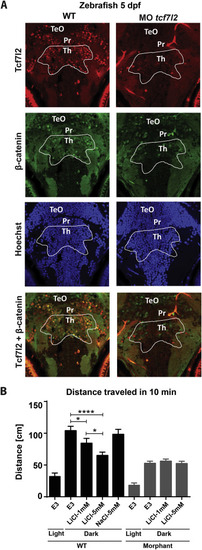- Title
-
TCF7L2 mediates the cellular and behavioral response to chronic lithium treatment in animal models
- Authors
- Misztal, K., Brozko, N., Nagalski, A., Szewczyk, L.M., Królak, M., Brzozowska, K., Kuznicki, J., Wisniewska, M.B.
- Source
- Full text @ Neuropharmacology
|
Silencing of tcf7l2 in zebrafish decreases the level of nuclear ?-catenin in thalamic neurons and attenuates the behavioral response to LiCl in zebrafish larvae. (A) Zebrafish brain slices were stained immunohistochemically with anti-TCF7L2 antibody (red), anti-?-catenin antibody (green), and counterstained with Hoechst nuclear dye (blue). TeO ? optic tectum, Pr ? pretectum, Th ? thalamus. (B) tcf7l2 morphant zebrafish larvae were exposed to LiCl at 2 dpf for 2.5 days, and thereafter dark-induced locomotion was measured. The chart represents the distance traveled by zebrafish larvae during 10 min in the dark or under the neutral light under the following conditions ? 5 mM NaCl, E3 medium, 1 mM LiCl, and 5 mM LiCl. The colors of bars indicate different groups of larvae, black ? WT, grey ? morphants. ****p < 0.0001, *p < 0.05 (two-way ANOVA followed by Tukey post hoc test). Error bars indicate SEM (n = 23?34). |
|
Morpholino-mediated silencing of tcf7l2 in zebrafish. (A) Increasing doses of tcf7l2 morpholino were injected into one-cell stage zebrafish and collected on 3 dpf. Tcf7l2 was detected by Western blot in total protein extracts. (B) Morphology of 5 dpf larvae. |


